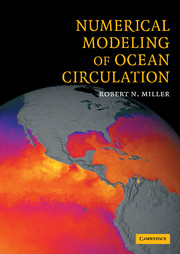7 - Models of the tropical ocean
Published online by Cambridge University Press: 19 February 2010
Summary
Introduction
Some of the most notable early successes in ocean modeling came in the 1980s in models of the tropical oceans, with most being applied to the tropical Pacific Ocean due to its role in interannual climate variability. The success of these models, many of which involved coarsely resolved simple linear dynamics, was due to a variety of factors. The standard by which success of these and many other models were judged was by comparison to pressure anomaly data in the form of sea level height anomalies or dynamic height increments. Sea level data carry the El Nino-Southern Oscillation (ENSO) signal, which is the phenomenon of greatest interest in the study of the tropical Pacific. Relatively rapid progress in models of the tropical ocean, as opposed to the mid-latitude or polar oceans is due, at least in part, to the agenda in tropical oceanography, which is focused on climate variability.
The success of the simple models stems from the fact that to some extent they contain the basic phenomenology of the interaction of largescale low-frequency atmospheric variability with the large-scale lowfrequency behavior of the fluid. When the early studies were performed, the only wind data sets available were coarsely resolved in space and time, and the only available ocean data sets with long enough time series to capture interannual climate variability consisted of depthintegrated pressure anomalies, i.e., data from tide gauges and expendable bathythermograph (XBT) data from volunteer observing ships (VOS); this latter data source is usually processed as dynamic height.
- Type
- Chapter
- Information
- Numerical Modeling of Ocean Circulation , pp. 199 - 230Publisher: Cambridge University PressPrint publication year: 2007



